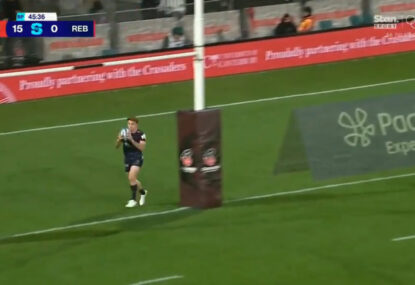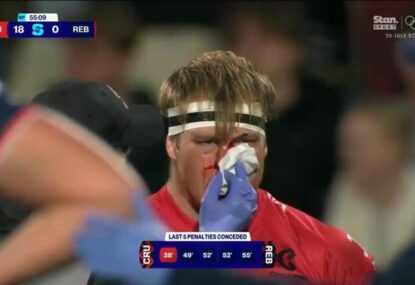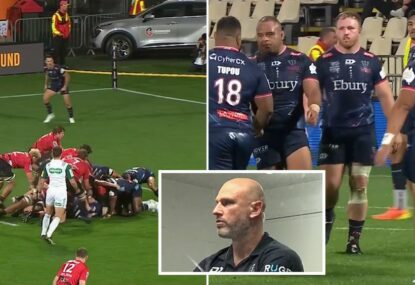Ireland’s 2016 Six Nations campaign began with a dogfight against Wales in the Aviva Stadium. The game finished 16-16 in what was, in hindsight, a decent result for an injury-ravaged Ireland team.
Ireland owned possession in the first quarter and stormed into a 13-0 lead by putting Wales through multiple phases at a time and building pressure until they forced the penalty.
They took the foot off the pedal in the final ten minutes of the first half, allowing Warren Gatland’s team back into the game. A grubber kick to nothing by Jonathan Davies in the 34th minute resulted in Andrew Trimble being forced to carry the ball over the line and concede a five-metre scrum.
The series of scrums that followed put Ireland under pressure, with their front row giving away a succession of penalties. On the third attempt, Taulupe Faletau picked from the base to score in the 37th minute. Rhys Priestland converted the try, bringing the score to 13-10.
Wales dominated possession in the first few minutes of the second half but were not able to capitalise due to resolute Irish defending.
Within the first 12 minutes of the second period, Ireland butchered three promising periods of pressure that should have led to points when they used misdirection off quick-ball lineout moves to drag Welsh defenders out of position and create linebreaks.
Both sides lacked accuracy going into the final quarter but they showed exceptional fitness levels to keep putting in bruising tackles. A kick at goal by Priestland in the 73rd minute put Wales ahead but Johnny Sexton managed to level the scores with a dramatic late kick.
Ireland’s front rowers struggled in the scrum against the Welsh but they out-played them in the loose. Jack McGrath and Rory Best made a lot of carries and tackles for front-row forwards, even late into such a tough contest.
Devin Toner imposed himself on proceedings in the absence of Paul O’Connell. He was Ireland’s primary lineout target (taking seven of Ireland’s nine throws) and he made several big tackles around the park. His monster carry following a Welsh knock-on in the ninth minute was a huge pressure-reliever for Ireland and it helped spark a counterattack after Ireland had come close to conceding a try.
Going into the game, Toner was faced with the daunting prospect of going up against the hard-nosed aggression and experience of Alun Wyn Jones and the lineout ability and work-rate of Luke Charteris, two players who have a significant advantage over him in terms of experience.
The Leinster second row more than gave a good account of himself and arguably had a larger influence on the game than either of his Welsh counterparts.
Tommy O’Donnell, Jamie Heaslip and CJ Stander in particular made a lot of yards with ball-in-hand as well as working tirelessly off the ball. O’Donnell has been viewed as a six-and-a-half by some but he played more like a genuine openside in this game, trailing the ball around the pitch and rushing off the line to hassle the opposition half-backs.
Stander at No.6 and Heaslip at No.8 looked imbalanced on paper but the two dovetailed nicely. Between them, they completed 29 tackles and carried the ball 38 times, with Heaslip’s average metres per carry (2.87) almost doubling that of Faletau’s (1.47).
Jérôme Garcès’ interpretation of the laws post-tackle was of no benefit to Wales. Gatland selected two openside flankers to disrupt Ireland’s possession and win turnovers. Sam Warburton and Justin Tipuric are two of the most effective players in the northern hemisphere when it comes to scavenging but their influence on the game was nullified by the fact that the man in the middle would not allow competition on the ground by either team.
It wasn’t just Wales that suffered as a result of the refereeing of the breakdown. Garcès’ decision-making as to when the tackle was completed also hindered what Ireland were trying to do without the pill.
A number of times throughout the game, the French referee was too quick to call ‘tackle’ when Ireland had managed to hold the Welsh ball-carrier up, simply because the tackled player dipped his leg towards the deck.
Luckily for Ireland, Conor Murray and Sexton left their club form behind them going into this game. One box-kick out on the full by Murray was the only blemish in a quality performance where he passed quickly, sniped around the fringes to good effect and used a clever show-and-go to score a try that gave his team the lead early in the game.
Sexton split the Welsh defence throughout the game in a commanding performance that saw him kick a long-range high-pressure penalty in the 75th minute. To do this under normal circumstances would be impressive but doing it after taking a heavy knock to the back of the head speaks volumes about the nerve of the player.
He threw a pass behind Jared Payne’s shoulder in the 55th minute that butchered a try-scoring chance but overall he was more composed than the error-prone Priestland.
The Bath out-half has never reached his 2011 Rugby World Cup performance levels, with his form being wildly inconsistent at times. The game would have unfolded differently if Dan Biggar did not have to leave the pitch in the 22nd minute with an ankle injury and Sexton may not have been given the same opportunity to shine.
Through their half-backs, Ireland executed a different gameplan than what they have used over the last two seasons. They varied the point of attack and used their forward ball-carriers and Robbie Henshaw to punch holes in the defence and get over the gain line.
Once Wales were on the back foot, Ireland got the ball into the hands of Payne and Simon Zebo to exploit the space out wide. When the Welsh players started showing signs of fatigue in the second half, Ireland used decoy runners and interplay between backs and forwards to manipulate the Welsh blitz defence, as well as getting Stander and Heaslip on to the ball in wider channels to good effect.
Ireland didn’t exactly play with reckless abandon but it was clear that Joe Schmidt had given them more license to play than in previous games. Their back row, in particular, looked to offload the ball after making big carries, rather than just going to ground. There were a number of occasions throughout the game where Ireland were expected to kick the ball but instead they spread it wide to force the Welsh to-realign.
From four of their nine lineouts, Ireland went for quick ball off the top to their back line in parts of the pitch that they would normally look to set up a driving maul and earn a penalty.
Henshaw was excellent for Ireland going forward. He burst through Welsh tackles off set-pieces and in open play to generate go-forward ball for his team. His match-up with Jamie Roberts was one of the most enjoyable contests in the game.
Payne had one of his best games in an Ireland jersey in both defence and attack, and he needed to because his opposite number was at his destructive best. Jonathan Davies threw everything at Ireland: outside breaks, straight-line running, well-weighted grubber kicks and scissors movements with his centre partner.
Payne expertly straightened the line in attack, distributed to his back three, drifted well in defence and his offload to Heaslip in the 48th minute set the No.8 on a marauding run that got Ireland deep into Wales’ half.
He won’t want to see his grubber-kick at the end of the game again but his performance demonstrated why Joe Schmidt has stuck with him despite the emergence of Garry Ringrose.
Keith Earls and Andrew Trimble got relatively few chances to show what they can do with ball-in-hand. Neither player had anything close to the same impact going forward as George North but they displayed a hunger and aggression in defence that provided Ireland with energy lifts when needed.
Zebo had a mixed game at fullback. He was beaten under the high ball a few times, although he did suffer a knee injury early on and this more than likely hindered his ability to compete in this area.
However, he was a constant danger with ball-in-hand. His injections into the attacking line created breaks and he put in a clever grubber kick behind the Welsh defence in the ninth minute to keep Ireland going forward when their attack had stagnated.
He counterattacked brilliantly in the 51st minute to slice through a dog-legged Welsh defence, giving Ireland a foothold in the Welsh 22. Even taking into account the mistakes, Zebo still managed to be one of the most dangerous players on the pitch in a game where Wales also picked a threatening runner at fullback in Liam Williams.
Looking ahead to their next game against France, an area of concern for Ireland is the scrum. In six of the game’s 12 scrums, Ireland were in serious trouble on Nathan White’s side. Certain commentators felt that Rob Evans was scrummaging illegally but the only thing that matters is how the referee views what’s going on.
France shoved aggressively on their own put-in against Italy and if Ireland can’t give the impression that they are being technically correct and hold their own against the French eight, it could end up losing the game for them.
They may have an advantage in the scrum, but France’s lineout was unstable against Italy due to Guilhem Guirado’s off-target throwing. Ireland are without their specialist lineout poacher Peter O’Mahony but still have a good chance of forcing mistakes from the French out of touch by getting Toner up quickly.
One of the better features of Ireland’s performance was their ball retention. They won 121 out of 124 rucks and this wasn’t just due to stringent refereeing. The amount of players they committed, the speed of their forwards to the ruck and the aggression and accuracy of their clearouts gave the Welsh little chance to interfere.
France competed aggressively against Italy at the breakdown but they were ill-disciplined and disorganised in doing so. If Ireland can bring the same level of cohesion and concentration to their ball security against the French, they could develop a serious advantage in this area.
An area where Ireland could do with a change in tactics is their restarts. Against Wales, they kicked long off most restarts to get a foothold in the Welsh half but this may not be wise against a French back three that will run the ball from anywhere.
For both Leinster and Ireland, Sexton has shown great skill in hanging the ball just beyond the ten-metre line for Toner to regather. Ireland will need to make use of this because it’s a part of the game where France have shown themselves to be competitive.
Last Saturday, France’s forwards went too upright into contact against Italy in almost every collision, with the intention of offloading to a support runner. They conceded a few turnovers early on in that game because the Italian defence did a god job of holding them up.
The Irish management will have identified this weakness and if Ireland are to successfully generate turnovers using their preferred defensive tactic, they will need Jaco Peyper to have more sympathy than Garcès did.
When Wales did move the ball towards the touchline, Ireland looked narrow but Payne and co. manged to drift across effectively and close down the space for the Welsh player. The same type of defence may not be effective against France on Saturday.
The quality of France’s passing against Italy was atrocious, even taking into account the Azzuri’s good line speed. However, when they did manage to get the ball wide, Virimi Vakatawa, Hugo Bonneval and Maxime Médard had no difficulty in exploiting the space that was afforded to them.
Ireland would probably be better served against the French by being aggressive in the five-metre channel rather than just drifting across.
France were abject in defence against Italy in more ways than one. Their line speed was non-existent, they were too slow to reorganise once Italy had gotten in behind, and Jonathan Danty and Gaël Fickou were extremely naive in defending the midfield.
Ireland’s pre-planned backline moves off set-pieces and their use of back rowers in wider channels could see them profit greatly by keeping the ball in hand against a passive French defence.
A win in Paris would not be impossible for Ireland, considering the flaws in France’s game as well as the personnel changes they will have to make in the back row.
Louis Picamoles’ injury means that France will be without their most explosive forward. Damien Chouly is likely to replace him at No.8 but the Clermont Auvergne captain is more of a lineout operator than a tackle-breaker.
There are other factors that are not in Ireland’s favour, though. The six-day turnaround after a draining encounter with Wales is not ideal preparation for a game against a formidable French pack.
France weren’t anywhere near the force of nature that most observers expect them to be in the first round, but Guy Novès is too good a coach to allow a repeat of the complacency that almost saw them lose to Italy at home.




































































































